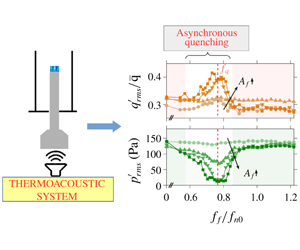Article contents
On the mechanism of open-loop control of thermoacoustic instability in a laminar premixed combustor
Published online by Cambridge University Press: 03 December 2019
Abstract

We identify mechanisms through which open-loop control of thermoacoustic instability is achieved in a laminar combustor and characterize them using synchronization theory. The thermoacoustic system comprises two nonlinearly coupled damped harmonic oscillators – acoustic and unsteady heat release rate (HRR) field – each possessing different eigenfrequencies. The frequency of the preferred mode of HRR oscillations is less than the third acoustic eigenfrequency where thermoacoustic instability develops. We systematically subject the limit-cycle oscillations to an external harmonic forcing at different frequencies and amplitudes. We observe that forcing at a frequency near the preferred mode of the HRR oscillator leads to a greater than 90 % decrease in the amplitude of the limit-cycle oscillations through the phenomenon of asynchronous quenching. Concurrently, there is a resonant amplification in the amplitude of HRR oscillations. Further, we show that the flame dynamics plays a key role in controlling the frequency at which quenching is observed. Most importantly, we show that forcing can cause asynchronous quenching either by imposing out-of-phase relation between pressure and HRR oscillations or by inducing period-2 dynamics in pressure oscillations while period-1 in HRR oscillations, thereby causing phase drifting between the two subsystems. In each of the two cases, acoustic driving is very low and hence thermoacoustic instability is suppressed. We show that the characteristics of forced synchronization of the pressure and HRR oscillations are significantly different. Thus, we find that the simultaneous characterization of the two subsystems is necessary to quantify completely the nonlinear response of the forced thermoacoustic system.
JFM classification
- Type
- JFM Papers
- Information
- Copyright
- © 2019 Cambridge University Press
References
- 15
- Cited by




